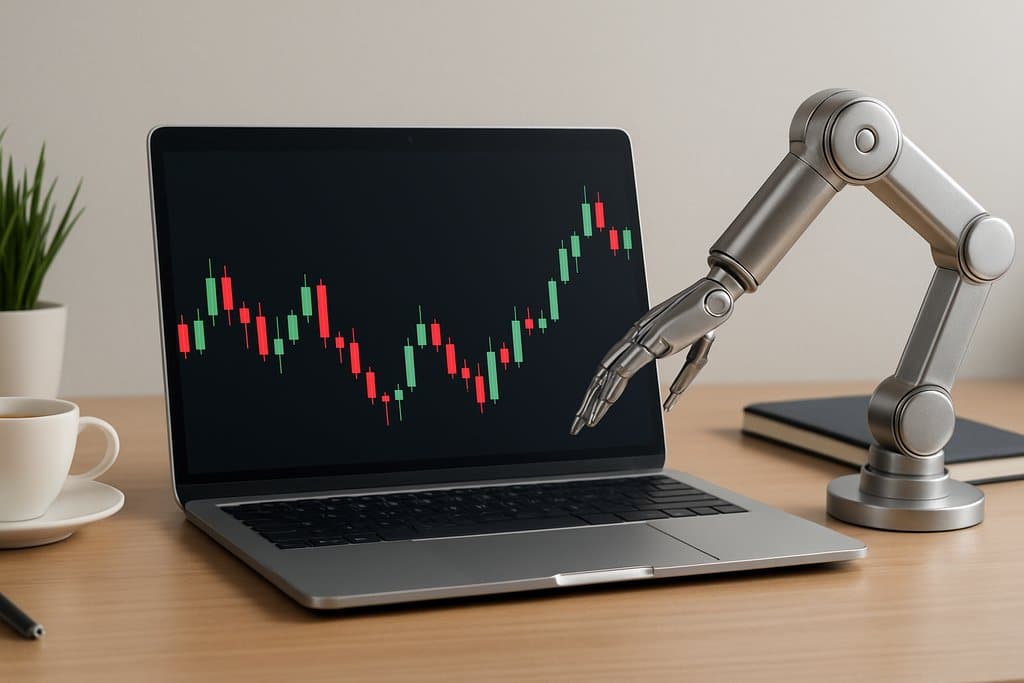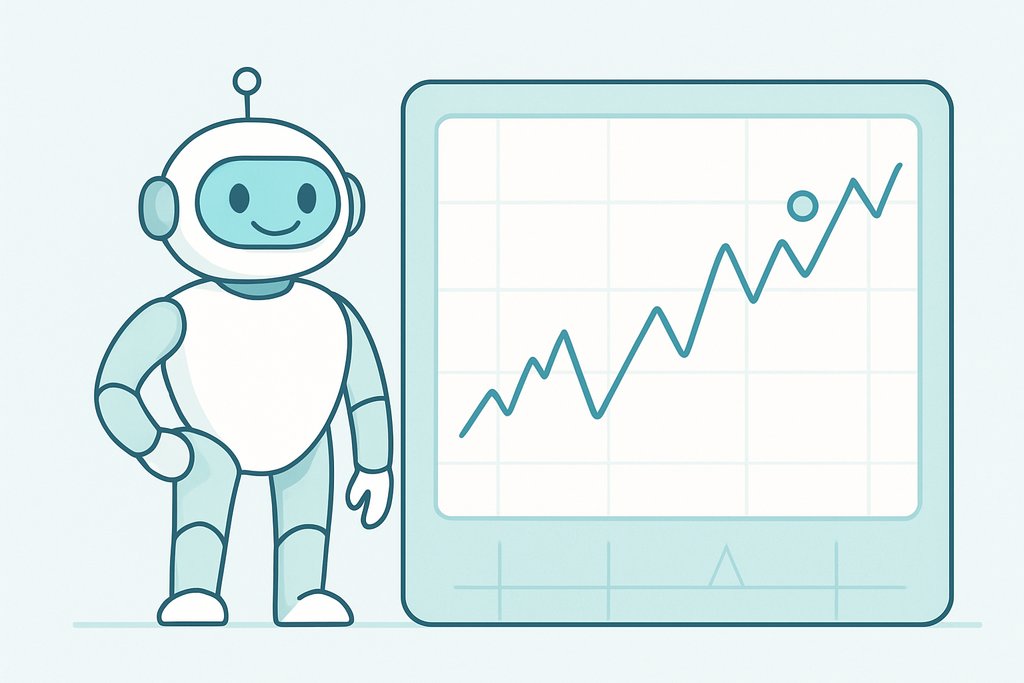Forex trading with robot: build and run smart FX bots
Learn forex trading with robot strategies: build, backtest, and run automated FX systems for disciplined 24/7 execution and faster signals.

Why traders search for forex trading with robot
If you are exploring forex trading with robot, you likely want two things that are hard to sustain manually. You want discipline that does not waver when the market whipsaws, and you want availability that covers the market around the clock. Foreign exchange trades twenty four hours a day during the week, spreads shift, news drops at inconvenient hours, and emotions creep in. A robot, also called an automated strategy or Expert Advisor, never gets tired, never deviates from rules, and can react in milliseconds to predefined signals. The intent behind this search is simple. Traders want a reliable process to turn a rule based idea into consistent execution and many want a practical path to get there without writing thousands of lines of code.
This guide goes deep on forex trading with robot, from the core concepts to strategy design, backtesting, deployment, and daily management. You will learn how to evaluate ideas, avoid common pitfalls like overfitting, and use modern tools such as Obside to go from plain language to live automation in minutes.
What forex trading with robot really means
At its core, forex trading with robot means delegating parts of the trading loop to software. The loop has four steps. You define the strategy rules, the robot listens for data and checks those rules, it sends orders when conditions are met, and it manages the position until exit. In traditional setups, robots run inside a platform such as MetaTrader as Expert Advisors, sometimes called EAs. You will also find algorithmic trading described in academic and professional contexts as the systematic application of a set of instructions to market data. If you want to dig into terminology, Investopedia has a clear overview of what an Expert Advisor is, and Wikipedia provides a good introduction to algorithmic trading concepts.
The robot does not have to be a mysterious black box. It can be a simple rule like buy EUR or USD when the 20 period moving average crosses above the 50 period moving average on the 1 hour chart, then place a stop loss at 1 ATR and take profit at 2 ATR. Or it can be a multi input condition that waits for RSI to cross 70 while MACD turns bearish, then shorts GBP or USD with a time based exit before London close. Modern platforms such as Obside let you express these ideas in plain English, then test and run them without writing code. For broader context on systematic workflows, see our guide on algorithmic trading in 2025.
How a forex robot works, end to end
Data ingestion is the base. The robot reads price ticks or candle data, plus any indicators derived from that data, and sometimes external inputs like economic calendar releases or news headlines. Signal generation follows. The robot evaluates your conditions on each new data point, for example checking whether the Supertrend is bullish on the 2 hour chart while it is also bullish on the 8 hour chart, and whether RSI is below 70. Execution then translates the signal into orders at your broker. That includes order type, size, slippage control, and safety checks. Finally, risk management and monitoring keep the system within your limits, with stop losses, take profits, trailing stops, and portfolio level constraints. You should also expect basic telemetry, things like trade logs, error reports, and performance summaries.
Backtesting sits alongside this loop as your laboratory. A robust robot is one that wins across varied periods and market regimes. You will want to simulate your strategy on historical EUR or USD data to measure win rate, average trade size in pips, profit factor, drawdown, and Sharpe ratio. You should cross validate by using out of sample data and walk forward testing to avoid overfitting. Optimization should be constrained, not an exhaustive search for the single best parameter that only worked in one period. If you need a deeper primer, start with forex backtesting and compare tools in our backtesting software guide.
Strategy types that suit forex trading with robot
Trend following remains a staple because FX pairs often trend after macro catalysts. A robot can define trend with moving averages, Donchian channels, or a Supertrend filter, and then pyramid or trail intelligently. Mean reversion shines in range bound periods, especially on major pairs during quiet sessions. Signals such as RSI returning from oversold or a Bollinger Band touch with confirmation can be codified and tested.
Breakout strategies align well with session opens or calendar events. For example, a robot can wait for a London session break above the Asian range, then enter with a stop at the midpoint of the range and a risk multiple target. News reactive logic is increasingly accessible. With platforms like Obside, you can tie conditions to headlines or macroeconomic data, for example buy USD or JPY if a risk off event triggers and volatility spikes, or stand aside if a central bank announcement is scheduled within the next hour.
Carry and swap considerations can be included, especially if you hold positions overnight. Although pure carry strategies have nuances, a robot can filter entries to when carry is favorable and trend supports the bias, then manage roll costs accordingly.

Practical, step by step guidance to build a robot without coding
You can build your first automated forex strategy in a structured way that keeps you safe from the typical traps. The steps below assume you use Obside, an automation platform that converts plain language rules into real trading actions. Obside was awarded the Innovation Prize 2024 at the Paris Trading Expo and is supported by Microsoft for Startups. Its backtesting engine is extremely fast, which reduces the friction between idea, validation, and execution. For implementation details from idea to live orders, see trading automation.
Step 1 — define a simple, testable idea
On EUR or USD M15, buy when there is a bullish divergence on RSI, set a stop loss at the low of the day, and take profit at 1.5 times risk. Write it out in plain language without ambiguity.
Step 2 — express it to Obside Copilot
Chat with the assistant and say, buy EUR or USD when RSI divergence turns bullish on the 15 minute chart, but only if MACD histogram is rising, place a stop at the daily low and a 10 percent take profit from entry, and close the trade if the divergence disappears. The Copilot turns this into a strategy that you can backtest.
Step 3 — backtest, then challenge the result
Run the simulation across at least two years that include both trending and choppy periods. Look at profit factor, drawdown, and number of trades. If results look too perfect with very low drawdown and very high win rate, you may be overfitting. Try changing parameters slightly to check robustness, for example RSI lengths of 13 or 21 rather than 14.
Step 4 — add risk management and position sizing
Size by percent of equity per trade, cap daily loss, and enforce a maximum number of open positions. In Obside you can say, risk 0.5 percent of my account per trade, stop trading for the day if daily loss exceeds 1.5 percent, and never hold more than three concurrent trades.
Step 5 — connect your broker and deploy
Obside connects to multiple brokers and exchanges, so after validating in the lab, you can switch to paper trading, then go live. Include protections like time filters, for example do not trade during the first 5 minutes after major economic releases.
Step 6 — monitor and iterate
Use telemetry to see slippage, average holding time, and variance in results between backtest and live. If performance deviates, review logs to understand whether execution, spreads, or market regime caused the difference.
Alert me if RSI crosses 70 on EUR or USD and MACD turns bearish; convert that alert into a conditional short with stop at 1.2 ATR.
Benefits of forex trading with robot, and key considerations
The primary benefit is consistency. A robot follows rules without hesitation. That removes revenge trades and overtrading after a loss. Speed and availability come next. FX moves rapidly around events, and a properly connected system can enter or exit in milliseconds across time zones. Coverage is broader when you automate. You can watch multiple pairs, timeframes, and conditions simultaneously, something that is hard to do manually.
- Consistency across sessions
- Fast, rules based execution
- 24/5 market coverage
- Built in risk controls
There are considerations that deserve equal attention. Overfitting is the silent killer. If you tune parameters to perfectly match historical noise, you will likely fail in live markets. Combat this by reducing parameters, using out of sample tests, and accepting slightly lower backtest metrics in exchange for robustness. Execution quality matters. Slippage, spreads, and latency can erode the edge of otherwise good rules. You should monitor average slippage per trade and, if your platform allows, set maximum slippage thresholds or switch order types in volatile periods.
Regime changes occur. A strategy that works in a low volatility carry environment may underperform during risk off shocks. Include regime filters, for example halt new entries when the Average True Range on the daily chart is above a threshold. Drawdowns are a fact of life. Plan for them with position sizing and a maximum drawdown stop. Finally, maintenance is part of the process. Review monthly, recalibrate if needed, and avoid frequent parameter tweaks based on short term outcomes.
If you want foundations on key metrics, Investopedia has clear articles on Sharpe ratio and drawdown. Their overview of Expert Advisors is also helpful for historical context. For a high level view of systematic trading, the algorithmic trading page on Wikipedia is a useful starting point.
Concrete examples you can run
RSI divergence reversal on EUR or USD
Define bullish RSI divergence on the 15 minute chart, require that the 2 hour trend filter is neutral or positive, and enter on a candle close. Place a stop loss below the swing low and a take profit at 1.8 times risk. Add a rule that closes the trade if RSI crosses 70 to avoid overstaying the rebound. Backtest across European session hours when liquidity is healthy.
Post news breakout with time stop
Before Non Farm Payrolls on the first Friday of the month, do nothing. Post release, define a 5 minute range once the first 15 minutes settle. If price breaks the range by 0.15 percent with volume confirmation and spreads are within normal bounds, enter with a tight initial stop. Set a time stop that exits after 90 minutes regardless of profit to avoid late session drift. Because Obside can listen to news or macro triggers, you can set a condition that arms the strategy only on those specific days.
Trend follow with multi timeframe trailing
Target the H4 timeframe on major pairs. Use a Supertrend filter on H4 and H1, enter on pullbacks when RSI on M30 returns from below 40 to above 50, and add a trailing stop at 5 times the 2 hour ATR. Close when the H1 Supertrend flips. This structure aligns a higher timeframe bias with a lower timeframe trigger, something robots implement cleanly and repeatably.
What to measure and how to interpret it
Win rate matters less than expectancy. Expectancy is the average amount you can expect to win or lose per trade, typically expressed in R, where 1 R equals your initial risk per trade. A system with a 40 percent win rate can be excellent if the average winner is 2.5 R and the average loser is 1 R. Profit factor, which is the ratio of gross profits to gross losses, tells you whether gains dominate losses. Sharpe ratio contextualizes returns by their volatility. Maximum drawdown tells you the worst historical peak to trough decline. Time in market reveals exposure, which affects risk during overnight sessions when spreads can widen.
Track slippage as a separate metric. For FX robots, half a pip per trade can swing results over hundreds of trades. Monitor trade distribution too. If most profits come from a handful of outliers, expect more variance in monthly results. In Obside you can review these metrics after each backtest, then decide whether to proceed to paper or live deployment.
Where Obside fits in your automation stack
Most traders struggle to bridge the gap between idea and implementation. Obside’s strength is speed and coverage. You describe your logic in plain language, the Copilot interprets it, and the backtester validates in seconds. You can attach conditions not only to prices and technical indicators but also to news and macroeconomic data. That means you can say, alert me if Bitcoin rises above a threshold and daily volume doubles, or notify me if RSI crosses 70 on EUR or USD and MACD turns bearish. You can also convert alerts into actions, for example buy 1,000 USD of EUR or USD if the price is below the 200 period moving average, or sell all my positions if volatility spikes beyond a set level.
Once validated, Obside executes with your connected brokers and exchanges, and it can manage portfolios with allocation rules. If you prefer to learn from others, Obside also offers a marketplace where traders share strategies that you can copy or adapt. Explore Obside at obside.com and create an account at beta.obside.com/register to start automating within minutes.
Conclusion and next steps
Forex trading with robot is not magic, it is process. Define clear rules, validate rigorously, deploy with risk controls, and monitor with discipline. The payoff is consistency, speed, and the ability to cover more opportunities without sacrificing sleep. If you already have a rule set in mind, try expressing it in plain language to Obside Copilot, backtest in seconds, then roll to paper and live once you are comfortable. If you are starting from scratch, pick one pair, one timeframe, and one simple edge, then let the robot enforce your plan with no exceptions.
FAQ
Is forex trading with robot profitable?
Profitability depends on the quality of your edge, execution, and risk controls. Robots amplify consistency but they do not create an edge by themselves. A simple, well tested strategy with modest expectations can be more sustainable than an over optimized system that looks perfect in backtests and fails live. Focus on expectancy, drawdown control, and robustness to parameter changes.
Do I need to code to run a forex robot?
Not necessarily. Platforms like Obside let you describe strategies in plain language, then handle the translation into executable rules. You still need to be precise about your logic and you must review the backtest and live logs, but you can avoid writing code. If you prefer traditional coding, platforms like MetaTrader allow Expert Advisor development in MQL, and cTrader supports cAlgo in C Sharp.
What timeframe works best for automated FX strategies?
It depends on your edge and constraints. Shorter timeframes require tighter execution and are more sensitive to spread and slippage, but they can offer more trade frequency. Higher timeframes are less noisy and more forgiving, though you will hold positions longer and face overnight events. Many traders find a balance by filtering trend on H4 or H1 and triggering entries on M30 or M15.
How do I avoid overfitting my forex robot?
Use out of sample testing, limit the number of tunable parameters, prefer simple rules over complex combinations, and evaluate robustness by perturbing inputs. Walk forward analysis, where you optimize on one period and test on the next, is a practical method to assess stability. Accept that a robust system may have less spectacular backtest metrics but will likely hold up better in live trading.
Can a robot handle news and macro events?
Yes if your platform supports those inputs. Obside can listen to news and macro data, which enables conditions like pause trading ahead of central bank announcements or rebalance allocations if volatility spikes. Even if you trade only technical rules, adding time filters around known events can improve consistency.






